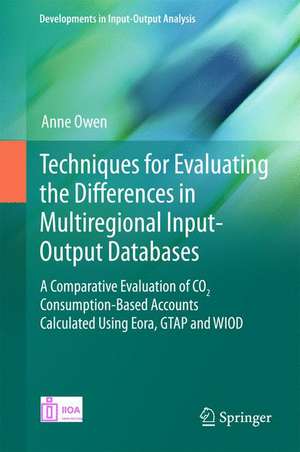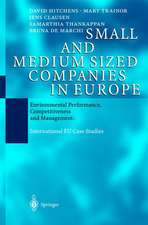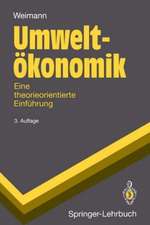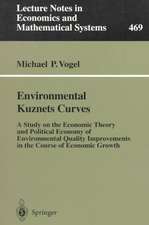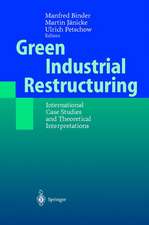Techniques for Evaluating the Differences in Multiregional Input-Output Databases: A Comparative Evaluation of CO2 Consumption-Based Accounts Calculated Using Eora, GTAP and WIOD: Developments in Input-Output Analysis
Autor Anne Owenen Limba Engleză Hardback – 17 feb 2017
It carefully explains the mathematical equations behind each technique and provides a link to a repository where the reader can access specially prepared MATLAB functions associated with the techniques. To make meaningful comparisons between the three MRIO databases, each is mapped to a consistent classification system comprising 40 countries and 17 sectors. Further, readers can access the aggregated databases using the link provided. The effect of this aggregation is shown to be minimal, so readers can be confident that the aggregated versions of each database reflect the full-sized versions.
The book concludes by making recommendations as to how future MRIO databases could be accurately and consistently constructed and how they should be used in policy-making in light of the findings.
Endorsement
Anne Owen did a splendid job in comparing the most important Global Multiregional Input Output databases (GMRIO) available. She probably is the first to develop a good understanding what factors in GMRIO construction really contribute to uncertainties in carbon footprint analysis. A great achievement, packed in easy to understand language! Prof. Arnold Tukker
Scientific director CML Leiden, NL
With its thorough investigations and clear explanations of the differences in MRIO databases and outcomes, this book is compulsory reading for both skilled practitioners and scholars when starting any input-output analysis in a multiregional context.
Dr. Harry C. Wilting
Senior researcher, environment and economics
PBL Netherlands Environmental Assessment Agency, NL
A novel exposition on understanding some of the biggest datasets underpinning current global sustainability assessments. Dr. Owen straddles technical incision with practitioner relevant insights and includes a range of methodological advances that will ensure the continued relevance of this work for many years to come. Prof. Richard Wood
Industrial Ecology Program
NTNU, Norway
| Toate formatele și edițiile | Preț | Express |
|---|---|---|
| Paperback (1) | 729.06 lei 3-5 săpt. | |
| Springer International Publishing – 4 mai 2018 | 729.06 lei 3-5 săpt. | |
| Hardback (1) | 635.44 lei 38-45 zile | |
| Springer International Publishing – 17 feb 2017 | 635.44 lei 38-45 zile |
Preț: 635.44 lei
Preț vechi: 836.10 lei
-24% Nou
Puncte Express: 953
Preț estimativ în valută:
121.62€ • 126.48$ • 101.77£
121.62€ • 126.48$ • 101.77£
Carte tipărită la comandă
Livrare economică 10-17 martie
Preluare comenzi: 021 569.72.76
Specificații
ISBN-13: 9783319515557
ISBN-10: 3319515551
Pagini: 209
Ilustrații: XXII, 217 p. 44 illus. in color.
Dimensiuni: 155 x 235 x 18 mm
Ediția:1st ed. 2017
Editura: Springer International Publishing
Colecția Springer
Seria Developments in Input-Output Analysis
Locul publicării:Cham, Switzerland
ISBN-10: 3319515551
Pagini: 209
Ilustrații: XXII, 217 p. 44 illus. in color.
Dimensiuni: 155 x 235 x 18 mm
Ediția:1st ed. 2017
Editura: Springer International Publishing
Colecția Springer
Seria Developments in Input-Output Analysis
Locul publicării:Cham, Switzerland
Cuprins
Chapter 1 Introduction.- Chapter 2 Literature review.- Chapter 3 Methodology and data.- Chapter 4 Using matrix difference statistics to compare MRIO databases.- Chapter 5 Using decomposition techniques to determine cause of difference in MRIO databases.- Chapter 6 Discussion.- Chapter 7 Conclusion.- Chapter 8 List of References.- Chapter 9 Appendix.
Textul de pe ultima copertă
This book introduces the Eora, Global Trade Analysis Project (GTAP) and World Input-Output (WIOD) databases and provides detailed metadata on the data sources, database structures and construction techniques used to build each system. It offers a detailed account of how multi-regional input–output (MRIO) databases are used to calculate consumption-based accounts – guiding the reader through each mathematical step and explaining the associated equations. It demonstrates that different MRIO databases calculate different national level consumption-based CO2 accounts. If these results are to be used as evidence in climate policy-making, analysts need to be confident about the accuracy of the databases and understand why the results differ.
It carefully explains the mathematical equations behind each technique and provides a link to a repository where the reader can access specially prepared MATLAB functions associated with the techniques.
To make meaningful comparisons between the three MRIO databases, each is mapped to a consistent classification system comprising 40 countries and 17 sectors. Further, readers can access the aggregated databases using the link provided. The effect of this aggregation is shown to be minimal, so readers can be confident that the aggregated versions of each database reflect the full-sized versions.
The book concludes by making recommendations as to how future MRIO databases could be accurately and consistently constructed and how they should be used in policy-making in light of the findings.
It carefully explains the mathematical equations behind each technique and provides a link to a repository where the reader can access specially prepared MATLAB functions associated with the techniques.
To make meaningful comparisons between the three MRIO databases, each is mapped to a consistent classification system comprising 40 countries and 17 sectors. Further, readers can access the aggregated databases using the link provided. The effect of this aggregation is shown to be minimal, so readers can be confident that the aggregated versions of each database reflect the full-sized versions.
The book concludes by making recommendations as to how future MRIO databases could be accurately and consistently constructed and how they should be used in policy-making in light of the findings.
Caracteristici
Compares comprehensively the Eora, Global Trade Analysis Project (GTAP), and World Input-Output (WIOD) multi-regional input–output (MRIO) databases, for the first time Includes detailed descriptions of MRIO construction techniques Compiles a set of techniques for comparing input–output (IO) databases with detailed descriptions of how to use them Explores the causes of difference and comments on what this means for the future of MRIO development and their use in policy-making Includes supplementary material: sn.pub/extras
